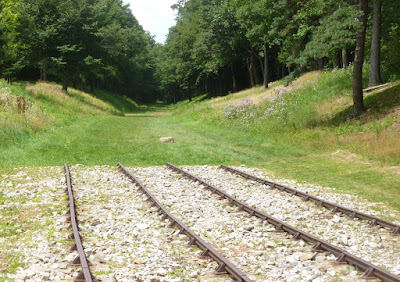During my younger days, I once read about a canal that went across Pennsylvania, which included a railroad that took canal boats over a mountainous area between two sections of artificial waterway. The Allegheny Portage Railroad National Historic Site near Gallitzin, PA preserves a small section of that railroad, which ran from Hollidaysburg, just south of Altoona, to Johnstown, later known for its tragic flood. The NHS also includes an engine house. In each engine house along the APR, there was a steam engine that pulled ropes attached to railcars on which canal boats rode up and down an inclined section of track. On level sections between the inclines, horses or locomotives pulled the boat-laden cars. This is the east side of the engine house.
These tracks run eastward and downhill from the engine house. In the distance is the Skew Arch Bridge, under which the tracks used to run.
In this closeup of the inclined track, we can see that the rails are made of wood clad with strips of metal.
Inside the engine house, the ropes used to pull the railcars are mounted on wheels, which would have been driven by the steam engine.
In the section of level track west of the engine house, the rails are made of steel and anchored via triangular supports. In the background is the Lemon House, a tavern built by businessman Samuel Lemon.
The Lemon House, as seen from its south side, is three stories tall.
Beyond the west end of the tracks, the old path of the APR can still be seen.
Inside the engine house was a small exhibit, including these replicas of two types of rope used by the APR. The earlier ropes (top) were made of hemp. They were eventually replaced by steel cables (bottom), developed by John Roebling, later known for building suspension bridges. The replicas are chained at one end to the exhibit table. Visitors can thus handle them and get an appreciation of their physical properties.
More information about the APR may be found at Exploring The Offbeaten Path and ExplorePAhistory.








No comments:
Post a Comment